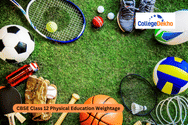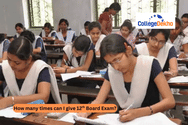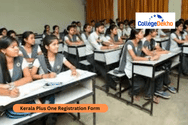- ISC Class 12 Physical Education Syllabus 2025-26 PDF
- How To Download ISC Class 12 Physical Education Syllabus 2025-26?
- ISC Class 12 Physical Education Syllabus 2025-26: Section A
- ISC Class 12 Physical Education Syllabus 2025-26: Section B
- ISC Class 12 Physical Education Practical Exam Pattern 2025-26
- ISC Class 12 Physical Education - List of Physical Efficiency …
- ISC Class 12 Physical Education Question Paper Pattern 2025-26


Never Miss an Exam Update
ISC Class 12 Physical Education Syllabus 2025-26: The Council for Indian School Certificate Examinations (CISCE) released the ISC Class 12 Physical Education Syllabus 2025-26 on the official website of CISCE. ISC Class 12 Physical Education Syllabus 2026 covers topics like the sociological aspects of physical education, training methods, health and career aspects in the field, and competition management. The important topics for this year include Sociological Aspects, Training Methods, Health Education, Career Aspects, Competitions and Tournaments, Sports Injuries and First Aid, and the Planning in Sports unit. The syllabus is divided into two sections. Students are required to answer five questions out of seven from Section A, each carrying 8 marks. Section B will be based on questions on major games in the syllabus. Students need to select two games from Section B. Read more: ISC 12th Exam Pattern 2026
The ISC Class 12 exam 2025 will tentatively be held from February 13, 2026, to April 5, 2026. The detailed ISC 12th Time Table 2026 will be released in December 2026 tentatively. The syllabus PDF can be downloaded from the official website of CISCE at cisce.org. Check the detailed ISC Class 12 Physical Education Syllabus 2025-26 here. Students can refer to the information and continue their revision for the board exams.
Read More: ISC Class 12 Syllabus 2026
ISC Class 12 Physical Education Syllabus 2025-26 PDF
Check the direct link to download the ISC Class 12 Physical Education Syllabus 2025-26 here and start your preparation:
Also read: ISC Class 12 Sample Paper 2026
How To Download ISC Class 12 Physical Education Syllabus 2025-26?
Follow the steps given below to download the ISC Class 12 Physical Education Syllabus 2025-26:
- Step 1: Students are first required to visit the official website of CISCE at cisce.org
- Step 2: On the homepage, they have to click on the Examinations option present on the menu bar.
- Step 3: From the drop-down menu, click on the ISC Examination option.
- Step 4: Scroll down and click on Regulations And Syllabuses on the new page.
- Step 5: Now, again click on the option called Regulations And Syllabus - ISC 2026
- Step 6: The list of syllabi will open on your screen.
- Step 7: Click on the Physical Education option to download the PDF.
ISC Class 12 Physical Education Syllabus 2025-26: Section A
The ISC Class 12 Physical Education Syllabus 2025-26 for Section A is mentioned in the table given below:
| S.No | Unit | Topic |
|---|---|---|
| 1 | Sociological Aspects of Physical Education | (i) Games and sports as man’s cultural heritage. |
| (ii) Development of the individual through games and sports. | ||
| (iii) Role of Physical Education in promoting national integration. | ||
| (iv) Physical Education and personality development. | ||
| 2 | Training Methods | (a) Meaning and importance of Sports Training. |
| (b) Methods of training. | ||
| (c) Warming up, conditioning, and cooling/limbering exercises. | ||
| (d) Isometric and Isotonic exercises. | ||
| (e) Circuit Training. | ||
| (f) Weight Training. | ||
| 3 | Career Aspects in Physical Education | (i) Career options in Physical Education. |
| (ii) Important institutions of Physical Education in India. | ||
| 4 | Competitions and Tournaments | (i) Tournaments and types of tournaments. |
| (ii) Difference between Professional and Amateur Players. | ||
| 5 | Health Education & Health Problems | (a) Meaning and definition of ‘Health’ and ‘Health Education’. |
| (b) Principles and importance of Health Education. Health problems and role of Health Education in solving them. | ||
| (c) Disability and Rehabilitation. | ||
| (d) Posture. | ||
| (e) Personal hygiene and sleep requirements. | ||
| (f) Substance Abuse. | ||
| 6 | Sports Injuries and First Aid | (i) Sports-related injuries |
| (ii) Role of a sportsperson in prevention of sports-related accidents. | ||
| (iii) First Aid. | ||
ISC Class 12 Physical Education Syllabus 2025-26: Section B
Students need to study two games out of Cricket, Football, Hockey, Basketball, Volleyball, Badminton, Tennis, Swimming, and Athletics. Check the game-wise syllabus here:
Game | Topics |
|---|---|
CRICKET | – Knowledge of the game, strategies and tactics, and how to improve performance. |
– Detailed understanding of the rules and regulations of the game. Diagrams of the field and pitch, and various fielding positions. | |
– Knowledge of the dimensions of the field, thickness of the lines, dimensions of pitch and complete specifications and markings on it. Equipment of the game with their length, width weight, thickness and material. Score board, scorer and sightscreen. Flood light. | |
– Duties of the officials, before, during and after the match. Umpires and third umpire, requirements of the game, equipment needed, numbers of players, duty of coach, captain etc. | |
– Laws governing the game. Suspensions, penalisations, draws, match fixtures, arrangements needed to conduct tournaments, forfeitures, follow on, tie, power play, match fixing, duck worth rule, sledging, ball tampering. | |
– Basic skills and techniques. Batting (different types of shots, footwork, body position and actual bat movement. Bowling (run up, delivery stride, follow through, types of bowling variations, good line and length, grip action. Fielding positions, catching and throwing skills, Wicket keeping techniques, skills of getting the batsmen out. | |
– Different types of signals, extra runs, extra players, runner, substitute, provisions and restrictions, players equipment, danger area, various terms of cricket. | |
– Knowledge of associations and federations linked to the game. Important tournaments. Abbreviations of associations and federations concerned with the game. | |
FOOTBALL | – Knowledge of the game, strategies and tactics, and how to improve performance. |
– Detailed understanding of the rules and regulations of the game. Match time, extra time, tie breaker, sudden death, ball in play and out of play, importance of lines on the field. Various methods of starting and restarting the game. Substitution procedure, penalty cards and their importance. | |
– Knowledge of the dimensions of the field, thickness of the lines, dimensions of center circle, quarter circle, goal and penalty area, penalty arc and complete specifications and markings on it. Equipment of the game with their length, width, weight, thickness, material and dimensions. Diagram of goal post and field. | |
– Duties of the officials, requirements of the game, equipment needed, numbers of players, duty of coach, captain, assistant referees, technical officials, grounds men, ball boys, match organizers, technical area. | |
– Laws governing the game. Suspensions, penalisations, draws, match fixtures, arrangements needed to conduct tournaments, punishment on players, coaches. | |
– Basic skills and techniques (Passing - types of pass, ground lofted, chip, volley, angle of pass. Control (use of various surfaces-head chest, foot thigh). Dribbling (running with the ball, rhythm and pace, feints, body swerves, screening, beating an opponent. Heading the ball with intention of (attacking, defending, jumping, to head down, high, pass, score.) Shooting skills with either foot, inside or outside, short and long range shots, swerving shots, volleys, penalty kicks, power and accuracy. Tackling skills - interception, jockeying for the ball, trapping by various body parts, position, tackle front, side, slide, recovery. Goalkeeping skills - stopping, watching, guiding the team, saving goal, dealing, catching, heading, kicking, punching, throwing, diving, anticipation, speed and reflexes. | |
– Principles of play-attack, depth, defence, penetration, sweeper systems, 4-4-2, 4-3-3, 4-2-4. Kick-off, corner kick, throw-in, goal kick, free kick, penalty kick. Importance of penalty arc, center circle and lines on the field. | |
– Knowledge of associations and federations linked to the game. Important tournaments. Abbreviations of associations and federations concerned with the game. | |
HOCKEY | – Knowledge of the game, strategies and tactics, and how to improve performance. |
– Detailed understanding of the rules and regulations of the game. Match time, extra time, tie breaker, sudden death, ball in play and out of play, penalty stroke, short corner, long corner, free hits, hit or push back, 16 yard hit, importance of lines on the field. Start and restart of the match. | |
– Knowledge of the dimensions and diagrams of the field and goalpost, thickness of the lines, dimensions and complete specifications and markings on it. Equipment of the game with their length, width, weight, thickness, material and dimensions. Protective equipment of the goalkeeper and players. | |
– Duties of the officials, requirements of the game, equipment needed, numbers of players, reserve bench, running substitution duty of coach, captain, assistant referees, ball boys, doctor, grounds men. | |
– Laws governing the game. Suspensions, penalisations, draws, match fixtures, arrangements needed to conduct tournaments, punishment on players, coaches. | |
– Basic skills and techniques (Passing - types of pass, ground lofted, chip, volley, angle of pass, push, scoop, flick, aerial ball. Receiving the ball – control, dribbling (running with the ball, rhythm and pace, feints, body swerves, screening, beating an opponent from the right to the left, right and behind. Shooting skills with Stick, inside or outside, short and long range shots, swerving shots, volleys, penalty, power and accuracy. Tackling skills - interception, jockeying for position. Goalkeeping skills - stopping, watching, guiding the team, saving goal, kicking, diving, anticipation, speed. Reflexes. | |
– Principles of play-attack, depth, defence, penetration, team formations 1-2-3-5/1-1-3-4-2/1-1-3-3. | |
– Knowledge of associations and federations linked to the game. Important tournaments. Abbreviations of associations and federations concerned with the game. | |
BASKETBALL | – Knowledge of the game, strategies and tactics, and how to improve performance. |
– Detailed understanding of the rules and regulations of the game. | |
– Knowledge of the dimensions of the court, thickness of the lines, diagrams and dimensions of the court, full specifications of the ring, pole, boards and ball. | |
– Duties of the officials, table officials, referees, scorers, requirements of the game, equipment needed, numbers of players, reserve bench, duty of coach, captain .technical equipment team and player foul markers | |
– Laws governing the game. Suspensions, penalisations, draws, match fixtures, arrangements needed to conduct tournaments. | |
– Basic skills and techniques, tactics and team skills Knowledge of basic skills, free throws stance (passing, dribble, shoot). Shooting (jump shot, layup, hook shot), passing (pass, signal, receive feint footwork, chest-pass, bounce pass, overhead pass, javelin pass. Footwork (pivot, 1 count and 2 count stop) One to one defence, fake and drive, pass and cut Defence, types of defence, zone defence, and fast break. | |
– Knowledge of associations and federations linked to the game. Important tournaments. Abbreviations of associations and federations concerned with the game. | |
VOLLEYBALL | – Knowledge of the game, strategies and tactics, and how to improve performance. |
– Detailed understanding of the rules and regulations of the game. | |
– Knowledge of the dimensions and diagram of the court, thickness of the lines, dimensions within the court, full specifications of the net, pole and other equipment required for the game. | |
– Duties of the officials, table officials, referees, requirements of the game, equipment needed, numbers of players, reserve bench, duty of coach, captain, etc. | |
– Laws governing the game. Suspensions, penalisations, draws, match fixtures, arrangements needed to conduct tournaments, default by teams. | |
– Basic skills and techniques, tactics and team skills Knowledge of basic skills, volley-two hand pass over the head forearm pass. The serve- underarm, over arm float, over arm jump, over arm top spin, round house jump. The smash - high set cross court, down the line, speed smash, tip the ball over the block. The block-line of defence, defence against smash, attack at set ball. Teamwork importance in both defence and attack. Understanding rotation, blocking and screening | |
– Knowledge of associations and federations linked to the game. Important tournaments. | |
Abbreviations of associations and federations concerned with the game. | |
BADMINTON | – Knowledge of the game, strategies and tactics, and how to improve performance. |
– Detailed understanding of the rules and regulations of the game. Match time, extra time, tie, shuttle in play and out of play, importance of lines on the court, singles and doubles. | |
– Knowledge of the dimensions and diagram of the court, thickness of the lines. Equipment required for the game with their length, width weight, thickness, material and dimensions. | |
– Duties of the officials, requirements of the game, equipment needed, number of players, duty of coach, match organisers. | |
– Laws governing the game. Suspensions, penalisations, draws, match fixtures, arrangements needed to conduct tournaments, punishment on players, coaches, match points, etc. | |
– Basic skills and techniques - forehand or backhand, correct grip, smash, drop, drive, net play, return upshots and low/high/flick serves. Basic positioning for men and women rallies. | |
– Knowledge of associations and federations linked to the game. Important tournaments. Abbreviations of associations and federations concerned with the game. | |
TENNIS | – Knowledge of the game, strategies and tactics, and how to improve performance. |
– Detailed understanding of the rules and regulations of the game. Match time, deuce, advantage, tie foot fault. Ball in play and out of play. Dimensions and importance of lines on the court, singles and doubles. | |
– Knowledge of the dimensions and diagram of the court net, racket, thickness of the lines. Equipment required for the game with their length, width, weight, thickness, material and dimensions. Types of courts. | |
– Duties and number of officials, requirements of the game, number of players, duty of coach, match organisers. | |
– Laws governing the game. Suspensions, penalisations, draws, match fixtures, arrangements needed to conduct tournaments, punishment on players, coaches, match points, etc. | |
– Basic skills and techniques - forehand or backhand, chopper grip, correct grip, smash, drop, drive, net play, return upshots and low/high/flick serves. Basic positioning for men and women rallies. The racket grip-shake hand. Strokes - backhand push, forehand drive, forward push. Service - two bounce serve, high toss, forehand spin, backhand spin, long serve. Spin - forehand topspin, backhand topspin chopping blocking lobbing, follow through, placement of ball for each service. | |
– Knowledge of associations and federations linked to the game. Important tournaments. Abbreviations of associations and federations concerned with the game. | |
SWIMMING | – Knowledge of competitive swimming events, activities, strategies and tactics, and how to improve performance (individual and team). |
– Detailed understanding of the rules and regulations of various swimming events, strategies and tactics in chosen events. Planning performing and evaluating particular event. | |
– Knowledge of the dimension, depth and distance of the pool. Importance of starters and judges for start and finish of individual and medley races. Various officials in charge of conducting the events. Types of races, types of strokes, diving competitions, false start, individual and medley events. Stances for different strokes. | |
– Duties of the officials, table officials, referees, requirements of the game, equipment needed, numbers of players, reserve bench, duty of coach, physiotherapist, wind gauge operator, lifeguard, photo finish. | |
– Laws governing the game. Suspensions, penalisations, draws, fixtures, arrangements needed to conduct tournaments. | |
– Basic skills and techniques requiring control, balance, weight transfer, flow and clear body positions, complex sequence of movements and ability to perform showing high standards of | |
precision control power speed and stamina, fitness and tactics to outwit the opponents. Warming up and cooling down safely, safety requirements for swimmers. | |
– Knowledge of associations and federations linked to the game. Important tournaments. Abbreviations of associations and federations concerned with the game. | |
ATHLETICS | – Knowledge of track and field events, activities, strategies and tactics, and how to improve performance (individual and team). |
– Detailed understanding of the rules and regulation of various events, strategies and tactics in chosen events. Planning performing and evaluating particular event. | |
– Knowledge of the dimension of the track. Width of the track. Measurement of 400 and 200 meters, relay and solo races. Equipment of athletes in various events dimensions and requirements. Importance of starters and judges for start and finish. Importance of staggers. | |
– Duties of the officials, table officials, referees, requirements of the game, equipment needed, numbers of players, reserve bench, duty of coach, physiotherapist, wind gauge operator, photo finish. | |
– Laws governing the game. Suspensions, penalisations, draws, match fixtures, arrangements needed to conduct meets. Rules and distances and requirements of various events. | |
– Basic skills and techniques requiring control, balance, weight transfer, flow and clear body positions, complex sequence of movements and ability to perform showing high standards of precision control power speed and stamina, fitness and tactics to outwit the opponents. Warming up and cooling down exercises. | |
– Knowledge of associations and federations linked to the game. Important tournaments. Abbreviations of associations and federations concerned with the game. |
ISC Class 12 Physical Education Practical Exam Pattern 2025-26
The ISC Class 12 Physical Education practical exam 2025 will be conducted for 30 marks. The maximum time duration for the Physical Education practical exam is 3 hours. The Practical Work will be evaluated in two sections as follows:- Continuous Evaluation (by the Teacher) 10 marks
- Practical Evaluation (by Visiting Examiner) 20 marks
Students can refer to the table below to know the ISC Class 12 Physical Education project work evaluation scheme 2025-26.
| Continuous Evaluation (by the Teacher) 10 Marks | |
|---|---|
| File Work done throughout the year on any two games/activities. | 4 Marks |
| Participation and performance of the candidate, throughout the year, in at least any two games/activities of his/her choice | 3 Marks |
| Physical Efficiency Tests | 3 Marks |
| Practical Evaluation (by the Visiting Examiner) 20 Marks | |
| Physical Efficiency Tests | 12 Marks |
| Specialisation Tests (The candidate is to be evaluated on any two basic skills of the two games/activities chosen by him/her for Continuous Evaluation) | 6 Marks |
| Viva-voce (on the two games/activities chosen by the candidate) | 2 Marks |
ISC Class 12 Physical Education - List of Physical Efficiency Tests
You can check out the list of physical efficiency tests to be conducted by the subject teacher as well as the external examiner.
Test 1 - 50 metre run, standing start: Timings to be taken to the nearest tenth of a second (weather should be relatively windless without extremes of temperature).
Test 2 - Standing long jump: A flat no no-slip surface should be used. The candidate should stand with toes just behind the take-off line and jump when ready. After making a preliminary swing with the arms, the candidate swings them forward vigorously, springing with both feet simultaneously to land as far forward as possible. Distance is measured in centimetres.
Test 3 - Distance run : 1000 metres run for boys, 600 metres run for girls. Time to be taken to the nearest second.
Test 4 - Floor push-ups for boys: The boy takes a front-leaning position with body supported on hands and balls of feet; the arms are straight and at right angles to the body. He then dips or lowers the body so that the chest touches or nearly touches the floor, then pushes back to the starting position by straightening the arms and repeats the procedure as many times as possible. Only the chest should touch the floor; the arms must be completely extended with each push-up; the body must be held straight throughout. Scoring consists of the number of correct push-ups.
Test 4 - Push-ups for girls : This is executed from a stall bar bench or a stool 32 cm high by 50 cm long and 35 cm wide. It should be placed on the floor about 15 cm from a wall so that the subject will not take a position too far forward. The girl should grasp the outer edges of the bench, or stool, at the nearest corners and assume the front-leaning rest position, with the balls of her feet on the floor and with her body and arms forming a right angle. She should then lower her body so that the upper chest touches the near edge to the bench or stool, then raise it to a straight arm position as many times as possible. The girl's body should be held straight throughout. If the body sways or arches, or if the subject does not go completely down or does not push completely up, half credit is given up to 4 half credits.
Test 5 - Shuttle run: A flat course of 10 metres is required to be measured between the two parallel baselines. Behind each baseline, a semicircle 50 cm radius with its centre on the baseline is required to be marked. In the far semicircle, two wooden blocks (5x5x5 cm) are to be placed. The candidate stands with feet behind the baseline, and on a signal, runs to the far line, picks up one block, which the candidate places in the starting semicircle when he/she returns. The candidate then repeats the procedure with the second block. The time to the nearest tenth of a second is to be taken till the second block is grounded in the starting semicircle.
Test 6 - 60-second sit-ups: The candidate lies with his/her back on a mat or flat surface, feet about 30 cm apart, and knees flexed at a right angle. The candidate's hand, with fingers interlocked, are placed behind the back. A partner holds the candidate's feet in contact with the mat or floor. On the signal "Go", the candidate sits up to touch the knees with his/her elbows. Without pause, he/she returns to his/her starting position and immediately sits up again. The number of sit-ups completed in 60 seconds is to be counted.
ISC Class 12 Physical Education Question Paper Pattern 2025-26
The ISC Class 12 Physical Education exam will be conducted for a total of 100 marks. The theory paper is of 70 marks and is three hours long. Students will be given 15 minutes before the exam to read the question paper. The ISC Class 12 Physical Education question paper will comprise objective, short-answer, one-word and long-answer type. The ISC Class 12th Physical Education exam paper will be divided into three sections: A, B, and C. Section A will carry 15 marks and consists short, 1-mark answers. Section B will carry 25 Marks and Section C will carry 30 Marks. All the questions will be compulsory but internal choice will be provided between questions in section B and C. The ISC Class 12 Physical Education question paper design is tabulated below:Section | Type of Questions | No. of Questions | Marks |
|---|---|---|---|
A | Objective or Very Short Answers | 1 x 14 | 14 marks |
B | Short Answer Questions | 7 x 4 | 28 marks |
C | Long Answer Questions | 4 x 7 | 28 marks |
Total | 70 marks | ||
ISC Class 12 Physical Education Syllabus 2025-26 is mentioned here. Check the detailed syllabus for both sections and prepare accordingly.
Are you feeling lost and unsure about what career path to take after completing 12th standard?
Say goodbye to confusion and hello to a bright future!

Was this article helpful?




















